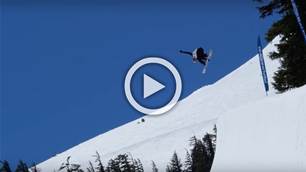At the age of 27, Crawford is a veritable veteran of the sport. She remembers the days when snowboarding was still an edgy pursuit for dreadlocked hoons.
At the age of 27, Crawford is a veritable veteran of the sport. She remembers the days when snowboarding was still an edgy pursuit for dreadlocked hoons.
If you’ve only ever seen a halfpipe competition on television, then I’d submit you don’t truly comprehend the physicality of this sport. Television flattens and foreshortens the pipe, making the speed look gentle, the tricks dainty. But watch a top-level competition in person, as I did when I stood on the lip of the Cardrona halfpipe and watched the finals of the NZ Winter Games in August – and you’ll be staggered by the dimensions of the pipe, the steepness of its pitch, the speed at which the snowboarders move down it, the airy grandeur of the tricks they pull and the bone-cracking horror of the inevitable stacks. Maybe it’s this rugged physicality that appeals to the Australian psyche. Because, make no mistake, with Torah Bright Olympic champion, and Nate Johnston and Holly Crawford FIS world champions, the Aussies are fast unseating the Yanks as the lords and ladies of the pipe. At the age of 27, Crawford is a veritable veteran of the sport. She remembers the days when snowboarding was still an edgy pursuit for dreadlocked hoons. She had her fun. These days it’s a professional pursuit peopled by finely honed athletes. And she’s dominating. Which is why I asked her to take us inside the pipe – this icy stage so dominated by Aussies and yet so foreign to this hot, brown land
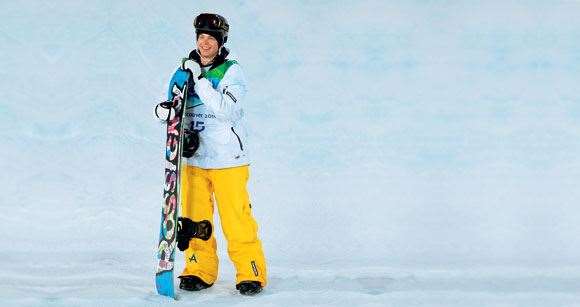 photos by Getty Images
photos by Getty ImagesHolding Speed
“The key to halfpipe? Basically, it’s all about being able to carve a snowboard. You need to be able to drop in and hold your line as you go across the flat of the pipe. If you can, you’re going to have enough speed to get out of the pipe. And once you’ve learnt how to get out, it just makes everything that much easier to learn coming back into the pipe.
“But if you drop into the pipe and just slide down it, you’re losing your speed. I see some of the girls drop in with a whole heap of speed and I think, ‘Shit, by the time they get to the other wall, they’re going to go massive.’ But then they just skid across the bottom of the pipe, washing off all that speed, so by the time they hit the other wall they’re only going, say, three feet above the coping [top of the pipe]. That just ruins a ride. It’s all about holding speed down the pipe. When you hit the wall, you’ve got to pump the wall ‒ like you would on a vert ramp ‒ to generate speed.”
The Hour Of Judgement
“Once you’ve learned to carve the board, you then need to master picking the right line; if you are having to change your line in the flat of the pipe then, again, you’re washing off speed. You also need to take a good line up the wall; if you go straight up the wall ‒ really vert ‒ then you’re not really going anywhere, just straight up in the air. But if you take a better line, if you move forward on the wall as you go up it, you’re going to get more air, you’re likely to land on the transition and you’re going to keep your speed into your next hit. This speed through the pipe is one of the key things the judges look for. If your first hit is six foot and then they tail away to three, you won’t get judged well. But if every hit stays the same height down the pipe ‒ or get bigger ‒ you’ll get points.
“Judges are also looking at how smooth you keep things. That’s often why the Japanese do so well; they just make everything look effortless. If you can make a trick look easy – whether or not it is – then you’ll be judged well. I think that’s why Nate and I have excelled over the last few seasons. We go to comps and see some of the other riders pushing themselves, pushing new tricks and big moves to impress the judges. But if you just stick to what you know, if you stick to what you know you can do well, you’re going to get through. That’s how Nate and I ride – we do the stuff we know we can do while everyone else is struggling and sketching. That’s something our coach Benny Alexander emphasised all last season: just do what you can do and do it really, really well. There’s no point getting to a competition and trying to learn a new trick in two or three days of training. That’s a pointless exercise ... ”
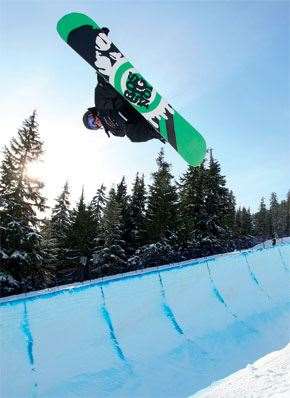 photos by, Getty Images
photos by, Getty ImagesTough Terrain
“Of course, the pipe can get pretty cut up. During the NZ Winter Games at Cardrona, for instance, it had been a warm day; the boys had been out on the pipe for hours and the snow had softened up. By the time we got in it was late afternoon, the shade had come in and the pipe had frozen again, so there were all these frozen ruts running up the wall. If you hit one of them, or get stuck in one, you’re kind’ve screwed. You just have to sit on it – you’ve got no choice. At World Cup events they’re always cutting the pipe and they’re sure to get it dead straight. But there’s not much they can do about weather. If it’s really warm and they’ve had a comp on it all day, the pipe’ll get cut up; if it rains all day, the pipe’ll fall apart. That happened at last year’s Worlds. It had been nice and warm all week and everyone had gotten used to riding the pipe like that. Then on comp day the weather came in. It was bleak and snowing. Everyone was like, ‘This isn’t right, what happened?’ You just have to learn to deal with that. You have to stay light on your feet. You have to be prepared for things to change. You can’t just hoe into the pipe, go at it, and think everything’s going to be okay. You have to trust yourself ‒ you can’t trust the pipe.”
Soft Landing
“Occasionally we train on trampolines or with air bags in the pipe so we can throw our tricks without worrying about having to land on our feet. But these things aren’t always as safe as they sound. I’ve blown my shoulder on a tramp and Hannah Trigger, who used to be on the team, dislocated her ankle on one. You’ve got to be careful. The difference with air bags and trampolines is that when you land, you stick. In the pipe you land and slide out of it. I think that’s where these injuries come from – your feet stick, your body keeps going and that’s when you hear that horrible popping noise.
“We’ve also done a lot of work into foam pits or off diving boards, but those things just don’t emulate the movement of snowboarding. Aerial skiers, for instance, are always asking us how we learn our tricks. You know, they’ll practise a trick 100 times into water before they even think about taking it onto snow. They can’t believe it when we tell them we learn our tricks in the pipe, on the ice. They think we’re insane. But there’s no other option – you can’t recreate the speed and movement of the halfpipe off a trampoline or a diving board.”
Bodily Harm
“Snowboarding’s definitely still got that edge. With the pipes getting bigger and people going bigger, injuries are rife. It’s certainly not safe, what we do. There’s a point where you have to stop and think about what you’re doing. I wouldn’t just throw, say, a double cork first thing in a session. I’d work into it and get to a point where I felt comfortable doing, say, a crippler. Then I’d move on ... I mean, there are still groups of people who are gung-ho, who’ll go out there and try whatever. But whenever I see them, they’re injured. There’s no point trying to punch out the impossible, then getting badly injured and having 12 months off.
“Saying that, injuries in the pipe are inevitable. I’ve broken my wrists, I’ve broken my ribs, I’ve had reconstructions. My physio says I’m never going to enjoy surfing because it’s just going to hurt too much ... I had a knee reconstruction in 2004; did a McTwist, landed badly, heard a pop ... After that, I got back on the snow and started dislocating my shoulder, so I had a shoulder recon in 2005 ... At the Olympics in ’06 I tried to break my pelvis – didn’t quite manage it, but came bloody close. I was drugged just so I could walk, let alone compete, so that Olympics was all a bit of a blur for me ... In 2008 I started getting some degenerating disks in my back. That was terrible. I couldn’t walk for two weeks. Doctors told me I wouldn’t compete at that level ever again. But I had a reconstruction on my other shoulder at that time, so I just did six-to-eight months of solid rehab and I got back in there in 2009. And I’ve done quite well since. I’ve had a few niggles here and there. I had a really good stack at Teignes, in the Euro X Games, at the end of last season, where I bounced off the coping, landed in the flat bottom and popped my rib cage again. I don’t think my ribs are ever going to go back to where they should be. When I’m at the beach in a bikini, people are always asking me, ‘Dude, what’s wrong with your rib cage?’ That’s just how it is ...
“Is there fear? Definitely – sometimes. Take that stack I had in Teignes. I was a reserve for that event, so I was just cruising. I was happy to go out there and be crazy – which I obviously paid for! Anyway ... It was just one of those stacks – there was nothing I could do. Even before I hit, I knew I was done. I was eight-odd feet out of a 20-foot pipe, so I knew I was falling a fair way, and as I popped and went to do my trick, I could see the coping beneath me, getting closer. I knew it was coming. And there was nothing I could do other than brace myself and hope for the best. Then I hit the coping and bounced into the bottom of the pipe, so I was bracing myself again. Not fun ... ”
Tricksters
“All the tricks are definitely planned before each run. In the qualies you wouldn’t be throwing your biggest run; you’d just be doing enough to get you through to the finals without hurting yourself. Then for the semis you’d have a run that’s a step up from that, and you’d carry on from there. Sometimes you have to think on your feet. You won’t land a trick as well as you should have, so you won’t have enough speed to do your next trick. You just have to adjust accordingly. That happens often enough. I’ve got a certain bag of tricks that fit – with variations – into a run quite happily. Sometimes, though, I’ll look at Nate on a run and I’ll just shake my head. He’s got such a bag of tricks that if he stuffs one up, he comes into the next frantically thinking, ‘Which one should I do?’
“A halfpipe run for girls generally consists of six hits. I usually do about five. In my bag I’ve probably got about eight tricks that are worth putting in a World Cup run. Nate, on the other hand, might only fit four tricks on a run, and he’s got a plethora of tricks. Plus, in World Cup competition, the rules demand you put a straight air in each run, so Nate basically has three tricks up his sleeve and he has to think, ‘Well, shit, what do I do? Straight air? Back ten? Front ten? Shit!’ It can become a bit of an overload ... Nate’s actually been known to run out of pipe! He’ll often put his straight air down the bottom – and he has to do it otherwise he’ll get docked
the maximum number of points. I’ve seen him turn back up the pipe just to fit it in ... ”
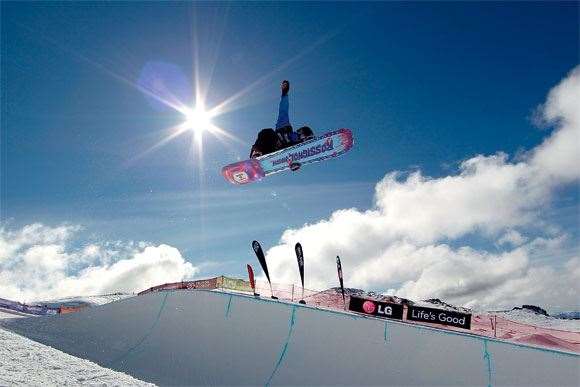 photos by, Getty Images
photos by, Getty ImagesBuilding the Bulk
“Obviously your quads are your main muscle group in the pipe. I’ve had people comment on the size of my quads and I’m like, ‘Well, if you stood in a squat all day for a living, I’m pretty sure your quads would be pretty big, too!’ But you also need strong gluts and calves because you’re rocking from your toes to your heals all day. Really, you just need an all-round muscularity. It’s good to have your bulk concentrated in your lower body, but you still need some muscularity up top. You know, if you’re throwing a spin, you’re using a lot of your core; if you’re falling, you’re putting your arm out and it’s being wrenched back. You need muscle to deal with that.
“Snowboarding is really changing at the moment. In the past it used to be a bunch of drongos, stoned or on the piss, out there having
a laugh, causing a ruckus, all this sort of stuff. But that’s changed now. Go to a World Cup event and the gym in town will be full of snowboarders. It definitely wasn’t like that when I started. Back then you’d finish a day of training and most of the boarders would be in
the pub. But people take it seriously these days. There’s testing standards for the international teams and all that jazz. Don’t get me wrong, though, at the end of a competition you’ll still find everyone in the pub ... ”
‒ Aaron Scott
Related Articles

Tess Coady wins Australia's first medal at the Beijing Olympics
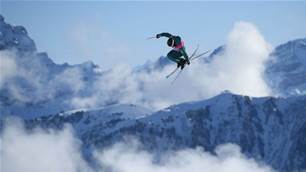
Winter Aussies Abroad: 2020 Youth Winter Olympics Recap
